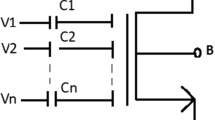Abstract
Great attention is paid to develop the nanotechnology fabrication techniques, but few attempts were done to develop special design techniques for the emerging nanotechnologies. In this paper, a new design approach for the multi-input XOR suitable for nanotechnologies is presented. This approach uses the multi-input majority function as a building block. The proposed method causes significant improvement in the gate level. The proposed design approach is deployed to CNFET 5-input and 7-input XOR circuit. The results show good improvements in the speed and number of devices.

Similar content being viewed by others
References
Lin, K.-J.; Wu, C.-W.: A low-cost realization of multiple-input exclusive-OR gates. In: ASIC Conference and Exhibit, 1995, Proceedings of the Eighth Annual IEEE International, pp. 307–310 (18–22 Sept 1995). doi:10.1109/ASIC.1995.580737
Hsiao, S.-F.; Wen, C.-S.; Tsai, M.-Y.; Chen, M.-C.: Automatic generation of high-performance multiple-input XOR/XNOR circuits and its application in Advanced Encryption Standard (AES). In: 2010 International Symposium on Next-Generation Electronics (ISNE), pp. 77–80 (18–19 Nov. 2010). doi:10.1109/ISNE.2010.5669194
Navi K., Farazkish R., Sayedsalehi S., Rahimi M.: A new quantum-dot cellular automata full-adder. Elsevier Microelectron. J. 41, 820–826 (2010). doi:10.1016/j.mejo.2010.07.003
Rahimi, M.; Kavehei, O.; Navi, K.: A novel design for quantum-dot cellular automata cells and full-adders. J. Appl. Sci. 7, 3460–3468 (2007). arXiv:1204.2048
Sayedsalehi S., Moaiyeri M.H., Navi K.: Novel efficient adder circuits for quantum-dot cellular automata. J. Comput. Theor. Nanosci. 8, 1769–1775 (2011). doi:10.1166/jctn.2011.1881
Sahafi, A.; Moaiyeri, M.H.; Navi, K.; Hashemipour, O.: Efficient single-electron transistor inverter-based logic circuits and memory elements. J. Comput. Theor. Nanosci. 10 (2013). doi:10.1166/jctn.2013.2824
Rehan, S.E.: An ANN majority logic gate (MLG) using single electron nano-devices. In: 2010 IEEE Asia Pacific Conference on Circuits and Systems (APCCAS), pp.983–986 (6–9 Dec. 2010). doi:10.1109/APCCAS.2010.5774904
Muroga S.: Threshold Logic & Its Applications. Wiley, NewYork (1971)
Feinstein, D.Y.; Thornton, M.A.: ESOP transformation to majority gates for quantum-dot cellular automata logic synthesis. In: Proceedings of the workshop on Applications of the Reed–Muller Expansion in Circuit Design and Representations and Methodology of Future Computing Technology (RMW), pp. 43-50 (May 16, 2007)
Ebbesen T.W., Ajayan P.M.: Large-scale synthesis of carbon nanotubes. Nature 358, 220–222 (1992). doi:10.1038/358220a0
Martel R., Schmidt T., Shea H.R., Hertel T., Avouris Ph.: Single- and multi-wall carbon nanotube field-effect transistors. Appl. Phys. Lett. 73(17), 2447–2449 (1998). doi:10.1063/1.122477
Martel R., Derycke V., Lavoie C., Appenzeller J., Chan K.K., Tersoff J., Avouris Ph.: Ambipolar electrical transport in semiconducting single-wall carbon nanotubes. Phys. Rev. Lett. 87, 256805 (2001). doi:10.1103/PhysRevLett.87.256805
Bradley K., Gabriel J.-C.P., Grüner G.: Flexible nanotube transistors. Nano Lett. 3, 1353–1355 (2003). doi:10.1021/nl0344864
Burghard M., Klauk H., Kern K.: Carbon-based field-effect transistors for nanoelectronics. Adv. Mater. 21, 2586–2600 (2009). doi:10.1002/adma.200803582
Sun D.-M., Liu C., Ren W.-C., Cheng H.-M.: A review of carbon nanotube- and graphene-based flexible thin-film transistors. Small 9, 1188–1205 (2013). doi:10.1002/smll.201203154
Deng J., Wong H.-S.P.: A compact SPICE model for carbon-nanotube field-effect transistors including nonidealities and its application—Part I: model of the intrinsic channel region. IEEE Trans. Electron Devices 54(12), 3186–3194 (2007). doi:10.1109/TED.2007.909030
Deng J., Wong H.-S.P.: A compact SPICE model for carbon-nanotube field-effect transistors including nonidealities and its application—Part II: full device model and circuit Performance Benchmarking. IEEE Trans. Electron Devices 54(12), 3195–3205 (2007). doi:10.1109/TED.2007.909043
Lin S., Kim Y.-B., Lombardi F.: Design of a ternary memory cell using CNTFETs. IEEE Trans. Nanotechnol. 11(5), 1019–1025 (2012). doi:10.1109/TNANO.2012.2211614
Moaiyeri M.H., Doostaregan A., Navi K.: Design of energy-efficient and robust ternary circuits for nanotechnology. Circuits Devices Syst. IET 5(4), 285–296 (2011). doi:10.1049/iet-cds.2010.0340
Navi, K.; Sharifi, F.; Momeni, A.; Keshavarzian, P.: Ultra High Speed CNFET Full-Adder Cell Based on Majority Gates. IEICE Transactions on Electronics, (2010). DOI:10.1587/transele.E93.C.932
Alkaldy E., Navi K., Sharifi F., Moaiyeri M.H.: An ultra high-speed (4;2) compressor with a new design approach for nanotechnology based on the multi-input majority function. J. Comput. Theor. Nanosci. 11, 1691–1696 (2014)
Kim, Y.B.; Kim, Y.-B.; Lombardi, F.: A novel design methodology to optimize the speed and power of the CNTFET circuits. In: 52nd IEEE International Midwest Symposium on Circuits and Systems, 2009 (MWSCAS ’09), pp. 1130–1133 (2–5 Aug. 2009). doi:10.1109/MWSCAS.2009.5235967
Zarhoun R., Moaiyeri M.H., Farahani S.S., Navi K.: An efficient 5-input exclusive-OR circuit based on carbon nanotube FETs. ETRI J. 36(1), 89–98 (2014)
Paul, B.C.; Fujita, S.; Okajima, M.; Lee, T.H.; Wong, H.-S.P.; Nishi, Y.: Impact of a process variation on nanowire and nanotube device performance. IEEE Tran. Electron Devices 54(9), 2369–2376 (2007)
Author information
Authors and Affiliations
Corresponding author
Rights and permissions
About this article
Cite this article
Alkaldy, E., Navi, K. & Sharifi, F. A Novel Design Approach for Multi-input XOR Gate Using Multi-input Majority Function. Arab J Sci Eng 39, 7923–7932 (2014). https://doi.org/10.1007/s13369-014-1387-x
Received:
Accepted:
Published:
Issue Date:
DOI: https://doi.org/10.1007/s13369-014-1387-x




